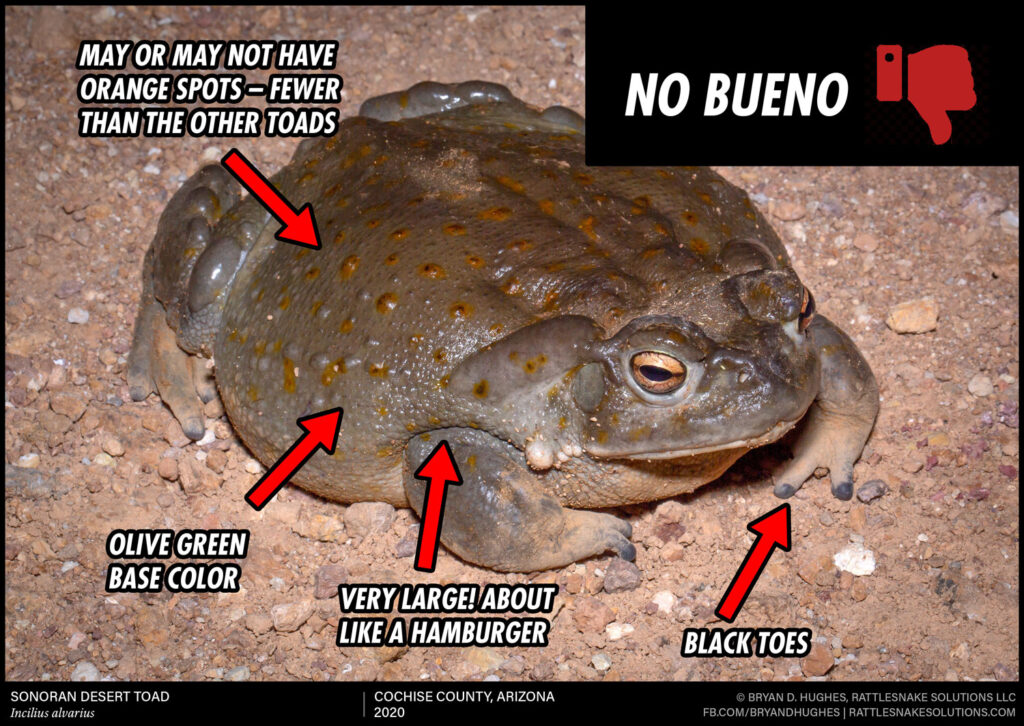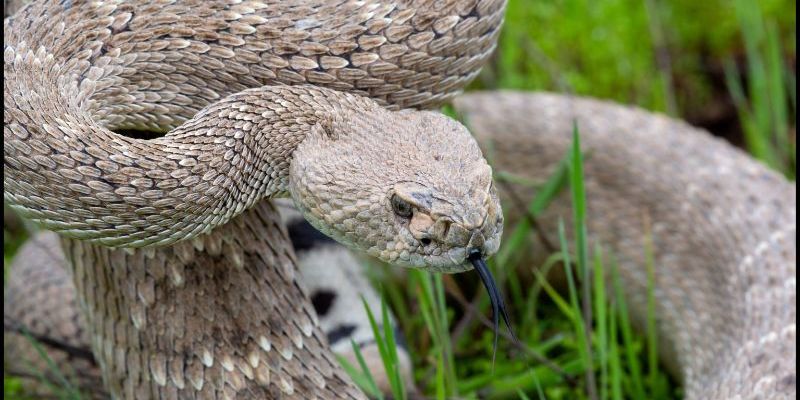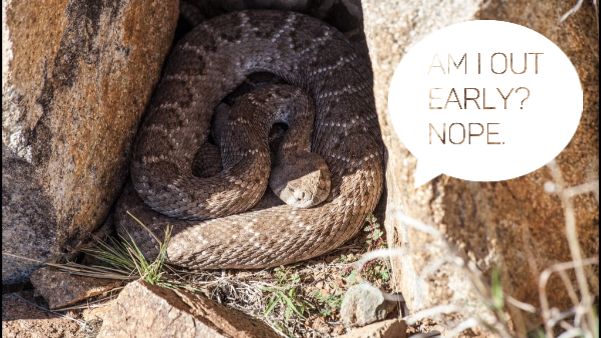During the monsoon each year, talk on social media turns to potentially deadly toads that can kill a dog very quickly. Of course, there are several species of toads that can be found in Arizona, and only one can be considered dangerous. This video tells you how to differentiate between these common toads.
Which toad is dangerously poisonous??
Of the 5 species of toads most common to the Phoenix and Tucson metro areas, only one can be considered dangerous. That is the Sonoran Desert Toad, or Colorado River Toad as they are also called. They are large, olive green toads with elongated poison glands behind the eye.
Other toads may also have poison glands and secrete toxin. However, they might at best, make your dog throw up if it eats them. Being able to tell one toad from the next is essential, and can save your dog’s life.
Identification key to the most common toads in Arizona
This is the Sonoran Desert Toad (or Colorado River Toad, as it is also referred to). These large toads, when under attack, will secrete a poison that can severely injure or kill a dog.

Next, perhaps the most commonly-seen toad in the county, the Red Spotted Toad. They are everywhere, and not something to worry about.

Next up: the Woodhouse’s Toad. They can pop up anywhere the others can, but seem to be more commonly associated with neighborhoods that border agricultural areas. If your dog chews on one, it could emit a toxin that might make your dog drool and possibly throw up … but is not a danger. If anything, I might speculate that a bad experience with a gross-tasting toad might even help give your dog some context to avoid chewing on the next one it sees.

Very similar in appearance to the Woodhouse’s Toad is the Great Plains Toad. It’s a stout-looking toad with a more reticulate, blotched pattern than the Woodhouse, but also often has a light colored stripe down the back. They have always looked, to me, to be the grumpiest of all toads.

Not as commonly seen, especially outside of the monsoon season, are these bright green, cat-eyed toads: Couch’s Spadefoot. These cute little guys are not a danger.

Tips to keep toads out of the yard
Keeping toads away from the property can be difficult, as they are highly mobile and can be drawn to any source of moisture. But there are some steps you can take to keep toads out of the yard.
- Reduce sources of moisture as much as possible. This may be drip systems and irrigation, leaky hoses, AC compressor drips, leaky pool pump areas, and more. Review the property at sunup before water has had a chance to evaporate and eliminate what you can.
- Keep patio lights off and reduce decorative lighting if possible. These lights bring in insects, which, in turn, bring toads in to eat them. It’s not uncommon to find toads hanging out under bright patio lights hunting, and fewer lights means fewer bugs to eat.
- Review landscaping and reduce plants that require excess water, and make sure there is no buildup of leaflitter under them.
- Purchase things like a Critter Ramp for the pool to get toads that fall into the pool back out (as well as rodents and snakes!
- Consider installing rattlesnake fencing. It’s not designed for toads, but it has a reduction effect and can be a useful tool in their prevention.
- Have dogs trained in toad avoidance. Ask your local dog trainer about it.

What to do if you have a poisonous toad in your yard?
- First, figure out what it is. If you’re not sure, you can send it to our team via email at id@rattlesnakesolutions.com or text a picture to 4806943020.
2. If it’s a harmless one, just leave it there and go on to step #4.
3. If it’s a Sonoran Desert Toad (the poisonous kind): you can move it elsewhere, then just wash your hands. Or you can call someone to remove it.
4. However, you really need to investigate to figure out why it’s there to begin with, and change that situation if you can. Even if you find one of the harmless toads listed here, it can be an indication that there is moisture nearby that can also bring in the big, poisonous toads. Removing unintentional water features like drips from a leaky hose or AC compressor can make a big difference.
I have caught the toads, where do I put them?
The toads you capture will need another, similarly-moist area to be relocated to, or they will not survive. This could be a nearby drainage, cattle tank, park, golf course, or anywhere you know there’s a little water and cover. If you know you could have some toads nearby, spend a little time on Google Maps to find an alternative place to take them. You should not take them far (as close as possible) and definitely not more than a mile or so away.
Then, it’s time to work on the source of the problem: your yard.
The toads you find in your yard are there because of provided moisture. If you remove toads but do not fix the source of the problem, you’ll just have more toads later.
What to do if your dog eats a poisonous toad.
It’s 2am, your dog isn’t coming in from the late-night pee break. You put on the slippers and head out into the yard to discover your pup chewing on a toad. What do you do?
- Remove the toad from the mouth of the dog immediately. The toad will not poison you by touching it, so just grab it and get it out – don’t waste time looking for gloves or a tool.
- Get the garden hose and run out the hot water, then wash the dog’s mouth out extremely well. You want to get all of the poison that may have been excreted off of interior tissue.
- WHILE THIS IS HAPPENING someone in the household should be on the phone with the 24 hour emergency vet that you’ve selected in advance. Do not wait.
- Ignore advice from social media, such as taking Benadryl or other home remedies. This toxin can kill a dog very quickly – do not gamble with bad information.
Disclaimer: we are not veterinarians; defer to your emergency vet’s advice. This list has been provided by emergency veterinary professionals as actions that could help in an emergency situation.

Be proactive – have your yard inspected
During the monsoon season each year, our rattlesnake removal crew sees a lot of toads while on the search for hidden reptiles. The fact is: toads kill just as many dogs, or more, than rattlesnakes … so it’s good for everyone involved to extend this service to help homeowners keep dogs safe from toads as well. Email toads@rattlesnakesolutions.com to learn more about what we can do to keep toads out of the yard.
What you can easily avoid here is the confusion and panic of trying to search for whoever is open and asking what to do. If you live where toads can be found (or snakes, for that matter), whatever planning you can do in advance is the best thing you can do and make the difference between your dog living or dying.
Carve an hour or two out of your day to search for 24 hour emergency veterinary hospitals. Call them, find out the pricing, protocol, and work out the plan from start to finish in advance. The difference in how well your dog can be treated, and how you feel during the very scary experience, can be very different if you’re enacting a plan rather than panicking in the dark.








